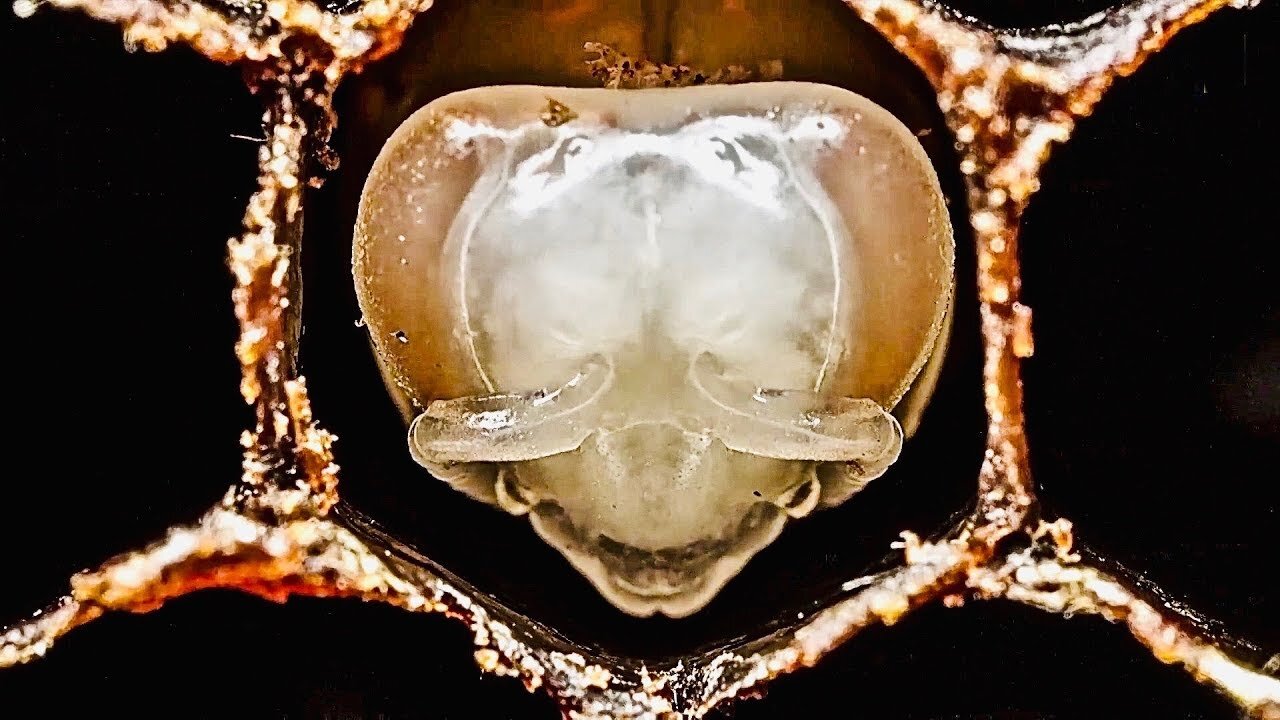Premium Only Content

How Bees Are Born ~ Amazing Footage
Stages of Bee Development - Egg -The queen lays one egg per cell. Knowing what the colony needs to survive, the worker bees have built appropriate cells for the queen. In most of the cells, she lays a fertilized egg that will develop into a worker bee. In cells that are slightly larger than the worker cells, she lays unfertilized eggs that will grow into drones. The egg stage of development lasts only three days. - Larva - After three days, the egg hatches into a worm-like form called a larva. The worker bees feed the larva royal jelly for the first few days and then switch to honey and pollen. An exception to this is a future queen: this larva continues its diet of royal jelly. A larva eats almost constantly and grows quickly. Within just five days, it grows 1 500 times larger than its original size. At this point, worker bees cap the cell with wax and the larva spins a cocoon around itself.
The larval stage lasts about six days. It's shorter for the queen, longer for the worker bees and longest for the drones.
Pupa
In the pupa stage, the tiny organism hidden under the capping is starting to look like an adult bee. Its legs, eyes and wings develop and, finally, the little hairs that cover its body grow.
After seven to fourteen days in this stage, depending on the type of bee, the now adult bee chews its way out of the cell. This stage is shorter for the queen, longer for the worker bees and longest for the drones.
Worker Bee
Worker bees are female but are not capable of reproducing. They do all the work in the hive, and they control most of what goes on inside. Their jobs include housekeeping, feeding the queen, drones and larvae, collecting the pollen and nectar, and making the wax. Because they work so hard, during the busy season worker bees live for only about six weeks.
Worker bees are shorter and more slender than drones and the queen, and their back legs have special baskets to help them collect pollen. Like the queen, they also have stingers, but they can only sting mammals once and then they die. They can, however, sting other insects over and over again to protect the hive.
Making Honey
Making honey is an important task for worker bees. They feed it to the developing larvae and also need it as a food source over the winter. The work involved in gathering nectar from flowers and transforming it into honey back in the hive requires that all the worker bees in a colony work together.
The honey made by bees is, of course, also enjoyed by people, as well as by other animals and insects.
Music: From Scales To Feathers (Thirsty Lizard Mix) by Dhruva Aliman
Amazon- https://amzn.to/2Mgr7pg
https://music.apple.com/us/artist/dhruva-aliman/363563637
https://dhruvaaliman.bandcamp.com/album/the-wolf-and-the-river
http://www.dhruvaaliman.com/
Spotify - https://open.spotify.com/artist/5XiFCr9iBKE6Cupltgnlet
#Bees #Nature #timelapse
-
 7:55
7:55
Knowledge Land
5 days agoShocking Scenes - 7.7 Earthquake Rocks Bangkok Thailand & Myanmar
111 -
 LIVE
LIVE
megimu32
2 hours agoON THE SUBJECT: Movies We Had Zero Business Watching.. But Totally Did!
176 watching -
![[Thursday Strike] 360 on his head | BloodStrike + Arena Breakout |](https://1a-1791.com/video/fww1/68/s8/1/N/z/6/A/Nz6Ay.0kob-small-Thursday-Strike-360-on-his-.jpg) LIVE
LIVE
ItsLancOfficial
4 hours ago[Thursday Strike] 360 on his head | BloodStrike + Arena Breakout |
69 watching -
 1:26:01
1:26:01
Kim Iversen
5 hours agoThe Fight Is ON: Grifters, Gatekeepers & Government Overreach
104K193 -
 LIVE
LIVE
TonYGaMinG
6 hours ago🟢 LIVE NOW - TARKOV ARENA BATTLEPASS GRIND #RumbleGaming
74 watching -
 2:16:31
2:16:31
Redacted News
5 hours agoLeaked Audio EXPOSES AIPAC's Shocking Grip on Trump's National Security Team and Inner Circle
167K90 -
 1:13:38
1:13:38
Dr. Drew
9 hours agoSalty Cracker: Tariffs & Deportations & 3rd Trump Term, Oh My! – Ask Dr. Drew
56.8K60 -
 LIVE
LIVE
VOPUSARADIO
1 day agoPOLITI-SHOCK! "ELECTION INTEGRITY MATTERS! WATCH LIVE AS WE EXPOSE THE FRAUD"! W/ Chris Gleason
38 watching -
 55:18
55:18
LFA TV
9 hours agoUndoing Decades of Corruption Won’t Come Easy | TRUMPET DAILY 4.10.25 7PM
21.9K2 -
 59:07
59:07
theDaily302
12 hours agoThe Daily 302- James Patrick
17.2K1